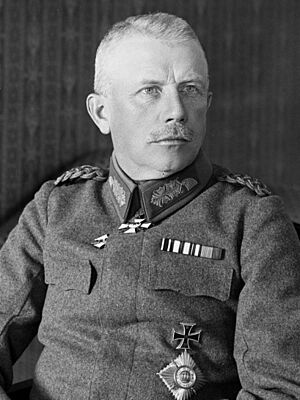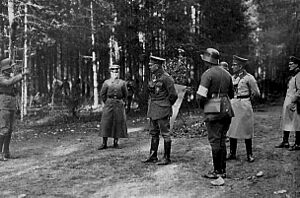Rüdiger von der Goltz facts for kids
Quick facts for kids
Graf
Rüdiger von der Goltz
|
|
|---|---|

Goltz in 1918
|
|
| Born | 8 December 1865 Züllichau, Province of Brandenburg, Kingdom of Prussia, German Confederation (present-day Sulechow, Lubusz Voivodeship, Poland) |
| Died | 4 November 1946 (aged 80) Bernbeuren, Upper Bavaria, Bavaria, Allied-occupied Germany |
| Allegiance | |
| Service/ |
Imperial German Army |
| Years of service | 1885–1918 |
| Rank | Major General |
| Commands held | Baltic Sea Division Baltische Landeswehr |
| Battles/wars | First World War Finnish Civil War Latvian War of Independence Estonian War of Independence |
| Awards | Iron Cross 1st Class Iron Cross 2nd Class Pour le Mérite 1st Class of the Order of the Cross of Liberty with crossed swords and precious stones |
Gustav Adolf Joachim Rüdiger Graf von der Goltz (born December 8, 1865 – died November 4, 1946) was a German army general. He played a key role during the First World War and the conflicts that followed.
In 1918, he led the Baltic Sea Division, a German military group. This group helped the nationalist government in the Finnish Civil War. After the war in Finland, Goltz stayed there with his troops. He had a lot of power and acted like a military leader for a few months.
After World War I ended in November 1918, Goltz took command of German troops in Latvia. These troops helped defeat the Russian Bolsheviks and their local allies in Latvia in 1919. However, his forces were later defeated by Estonian troops. They were not able to keep German control over Latvia and Estonia after the war.
Contents
Early Life
Rüdiger von der Goltz was born into the noble Goltz family. His birthplace was Züllichau, in what was then Brandenburg. His father was Count Gustav Albrecht von der Goltz, and his mother was Cäcilie von Perbandt.
Military Career
Before his famous campaigns, Goltz was a Major-General. He commanded the 1st Foot Guard Regiment in France during World War I.
Helping Finland in 1918
In March 1918, Goltz was sent to Finland. His mission was to help the Finnish nationalist government. They were fighting against the Finnish "Reds" and Soviet Russian troops in the Finnish Civil War.
Goltz led the German expedition unit, known as the "Baltic Sea Division". They landed in Hanko, Finland, in early April 1918. From there, they marched to Helsinki, the capital city. After the Battle of Helsinki on April 13, 1918, the city surrendered.
The German army's help allowed the Finnish nationalist government to control most of the country by May 1918. Goltz and his troops remained in Finland until December 1918. During this time, he had a strong political influence. Some even called him the "true regent of Finland."
Goltz wanted to create a new Finnish army. He planned for German officers to lead it. He also wanted Finnish soldiers to be trained like German soldiers. This idea caused some Finnish generals to resign in protest. The Germans hoped to use Finnish forces against Allied troops in northern Russia.
Actions in the Baltic States
After the armistice ended World War I on November 11, 1918, Goltz and his division left Helsinki. However, the Allied powers asked German troops to stay in Latvia and Estonia. This was to stop the Soviet Red Army from taking over these areas.
Many German soldiers were tired and leaving Latvia. So, a special unit called the "Iron Division" was formed. This unit was part of the Freikorps, which were volunteer military groups. They were sent to Riga to slow down the Red Army's advance. New volunteers from Germany joined them. Goltz was put in charge of these forces. Also, local Germans and some Latvians formed the Baltische Landeswehr, led by Major Alfred Fletcher.
In early 1919, only the port city of Libau (Liepāja) was still held by German and Latvian forces. In March 1919, General von der Goltz led his troops to several victories against the Red Army. They took Windau (Ventspils) and then advanced to retake Riga.
Conflict with the Allies
After the Bolsheviks were pushed out of most of Latvia, the Allies told Germany to remove its troops. But the Germans managed to delay their withdrawal. They argued that leaving would allow the Bolsheviks to return.
General von der Goltz then tried to take control of Latvia with the help of local Germans. The Latvian nationalist government was removed. The Freikorps, Latvian, and White Russian units then captured Riga on May 23, 1919. The Latvian nationalists asked for help from the Estonian army.
In June 1919, General von der Goltz ordered his troops to move north, not east. They attacked the Estonians instead of the Red Army. On June 19, his forces attacked areas around Wenden (Cēsis). But in the battles that followed, they were defeated by the 3rd Estonian Division. On June 23, the Germans began to retreat toward Riga.
The Allies again demanded that Germany withdraw its troops from Latvia. They helped arrange a ceasefire between the Estonians and the Freikorps. The British insisted that General von der Goltz leave Latvia. He then handed his troops over to the West Russian Volunteer Army in August 1919.
Later, in his memoirs, Goltz said his main goal in 1919 was to work with White Russian forces. He wanted to march on St. Petersburg (Petrograd) and overthrow the Bolshevik government. He hoped to set up a pro-German government in Russia.
Later Life
Goltz was involved in the Kapp Putsch on March 13, 1920. This was an attempt to overthrow the German government.
In the early 1930s, he was President of the United Patriotic Associations of Germany. He also took part in the Harzburg Front, a political alliance.
From 1924 to 1930, he led a German group that focused on military education for young people.
He passed away on November 4, 1946, in the village of Bernbeuren, Germany.
Personal Life
On March 3, 1893, Rüdiger von der Goltz married Hannah Caroline Helene Marie von Hase in Potsdam. They had three sons:
- Count Gustav Adolf Karl Joachim Rüdiger von der Goltz (1894-1976), who became a lawyer and politician.
- Count Hans von der Goltz (1895-1914).
- Count Georg-Conrad Gustav Dankwart Carl Gottfried von der Goltz (1902-1985).


